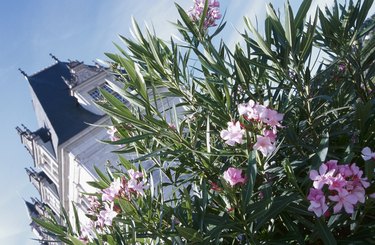
Although it's an attractive plant, all parts of the shrub oleander (Nerium oleander) are poisonous; the sap can cause dermatitis, and it's considered invasive in some regions. When considering alternatives, select shrubs with similar growth characteristics. Oleander, an evergreen, grows 4 to 8 feet tall in U.S. Department of Agriculture plant hardiness zones 8 through 10. It tolerates drought and bears purple, pink or white blossoms seasonally. Gardeners typically use oleander as an accent plant, as well as for hedges, borders and privacy screens.
Edible Fruit Advantage
Video of the Day
For an edible alternative, try oleaster (Elaeagnus x ebbingei) and pineapple guava (Feijoa sellowiana). Oleaster makes a good privacy screen, windbreak or hedge and grows 8 to 10 feet tall in USDA zones 7 through 9. Its creamy white flowers blossom in the fall, followed by reddish-brown fruit in the spring. Highly drought-tolerant, pineapple guava grows 10 to 15 feet tall in USDA zones 8 through 11 and can serve as a privacy screen. The white or red flowers turn into yellow-green fruit.
Video of the Day
Fast Growth
Get your landscape going quickly when you choose fast-growing alternatives to oleander. Tough and reliable, elephant plant (Portulacaria afra), also known as small-leaf jade, is a succulent shrub that hardly ever requires pruning. A nice accent plant or informal hedge, it grows about 4 feet tall and begets pink flowers. Hop bush (Dodonaea viscosa), also known as varnish leaf, makes a nice privacy screen and also livens up the look of parking lot islands. It grows 10 to 15 feet tall, bears yellow flowers that turn into showy pods, and requires little irrigation. Both shrubs grow in USDA zones 9 through 11.
Hedges You Can Shear
Shear-friendly shrubs are a good choice if you want manicured hedges. To create a 6- to 15-foot-high background or privacy screen for a sunny site in USDA zones 7 through 11, try sugar bush (Rhus ovata). This shrub blooms with cream flowers that attract bees, followed by small reddish, ornamental fruit. Columnar American arborvitae "Fastigiata" (Thuja occidentalis "Fastigiata") has an erect, columnar canopy that can grow about 25 feet tall, unless you shear it. It makes nice privacy screen, requires little irrigation and grows in USDA zones 5b through 10.
Create a Barrier
To fashion a barrier at the edge of your yard, try crown of thorns (Euphorbia milii) or big-leaf podcarp (Podocarpus macrophyllus). Crown of thorns gives you a thorny barrier 3 to 6 feet tall in USDA zones 9 through 11. A winner for places with dry soil and air pollution, it bears red or yellow flowers and resists both deer and rabbits. For a lofty privacy screen barrier 20 to 35 feet tall, try shrubby podocarpus "Maki" (Podocarpus macrophyllus var. maki) in USDA zones 7 through 11. The insignificant flowers on this slow-growing, drought-tolerant columnar shrub yield small, ornamental purple-red fruit.
- Missouri Botanical Garden: Nerium Oleander
- University of Florida IFAS Extension: Feijoa Sellowiana
- Missouri Botanical Garden: Elaeagnus x Ebbingei
- Arizona State University: Portulacaria Afra
- University of Florida IFAS Extension: Dodonaea Viscosa -- Varnish Leaf, Hopbush
- Arizona State University: Rhus Ovata
- Cal Poly Urban Forest Ecosystems Institute: Columnar American Arborvitae
- Missouri Botanical Garden: Euphorbia Milii
- North Carolina State University Department of Horticulture: Podocarpus Macrophyllus Var. Maki
- Gardenality: USDA / Sunset Zones Climate Conversion Chart
- San Diego Master Gardener Association: Good Bets for Hedges to Replace Dying Oleanders